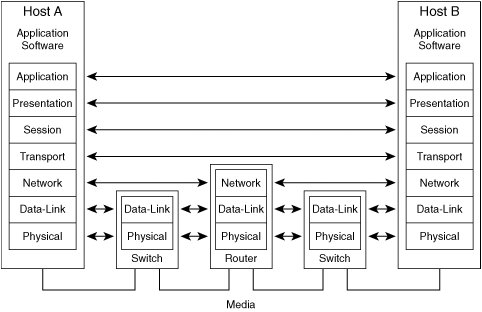OSI Model question
in CCNA & CCENT
I am trying to visualize the OSI model but am having some confusion.
I don't understand this because first of all, if we are going to follow the OSI hierarchy (but starting from the Network layer and sending data outside of the LAN) I see the packets traveling in this order:
Transmitting- Router (Network layer) > Switch (Data Link layer) > Cables (Physical layer)
Receiving- Cables (Physical Layer) > Switch (Data Link layer) > Router (Network Layer) > Host (Tansport layer, Session Layer, Presentation Layer, Application Layer).
Shouldn't the data travel in this way:
Transmitting- Router (Network) > Cables (Physical)
Receiving- Cables (Physical) > Router (Network) > Switch (Data Link) > Host (Tansport layer, Session Layer, Presentation Layer, Application Layer).
I don't understand this because first of all, if we are going to follow the OSI hierarchy (but starting from the Network layer and sending data outside of the LAN) I see the packets traveling in this order:
Transmitting- Router (Network layer) > Switch (Data Link layer) > Cables (Physical layer)
Receiving- Cables (Physical Layer) > Switch (Data Link layer) > Router (Network Layer) > Host (Tansport layer, Session Layer, Presentation Layer, Application Layer).
Shouldn't the data travel in this way:
Transmitting- Router (Network) > Cables (Physical)
Receiving- Cables (Physical) > Router (Network) > Switch (Data Link) > Host (Tansport layer, Session Layer, Presentation Layer, Application Layer).
Comments
-
 wastedtime
Member Posts: 586 ■■■■□□□□□□
Not really sure what you are getting at in that post but maybe this picture will help.
wastedtime
Member Posts: 586 ■■■■□□□□□□
Not really sure what you are getting at in that post but maybe this picture will help.
The lines at the bottom are the path that the data would be taking through the network. -
 IRONMONKUS
Member Posts: 143 ■■■□□□□□□□
I like that diagram, thank you. I never thought about the different layers that might take place within the switches and routers.
IRONMONKUS
Member Posts: 143 ■■■□□□□□□□
I like that diagram, thank you. I never thought about the different layers that might take place within the switches and routers. -
 Technology1
Member Posts: 50 ■■□□□□□□□□
Here's another one.
Technology1
Member Posts: 50 ■■□□□□□□□□
Here's another one. IRONMONKUS wrote: »I like that diagram, thank you. I never thought about the different layers that might take place within the switches and routers.
IRONMONKUS wrote: »I like that diagram, thank you. I never thought about the different layers that might take place within the switches and routers. -
 Greenmet29
Member Posts: 240
Wastedtime...That picture is pure genius. I understood the way that data passes through the network already, but this diagram reinforced what I already thought I knew! Thanks!
Greenmet29
Member Posts: 240
Wastedtime...That picture is pure genius. I understood the way that data passes through the network already, but this diagram reinforced what I already thought I knew! Thanks!
-
 bencmcb
Users Awaiting Email Confirmation Posts: 43 ■■□□□□□□□□
This was very helpful. Thank you.
bencmcb
Users Awaiting Email Confirmation Posts: 43 ■■□□□□□□□□
This was very helpful. Thank you.
Is the Network layer not being used when data is traveling within a LAN? -
 Greenmet29
Member Posts: 240
It is, but not at the switch. When the receiving node gets it, it check the destination network layer address (IP Address) and if the packet belongs to that node, it strips the network layer header off and passes it to the transport layer. If it doesn't (could be a broadcast or unknown unicast), it discards the packet.
Greenmet29
Member Posts: 240
It is, but not at the switch. When the receiving node gets it, it check the destination network layer address (IP Address) and if the packet belongs to that node, it strips the network layer header off and passes it to the transport layer. If it doesn't (could be a broadcast or unknown unicast), it discards the packet. -
 hermeszdata
Member Posts: 225
Greenmet29 wrote: »It is, but not at the switch. When the receiving node gets it, it check the destination network layer address (IP Address) and if the packet belongs to that node, it strips the network layer header off and passes it to the transport layer. If it doesn't (could be a broadcast or unknown unicast), it discards the packet.
hermeszdata
Member Posts: 225
Greenmet29 wrote: »It is, but not at the switch. When the receiving node gets it, it check the destination network layer address (IP Address) and if the packet belongs to that node, it strips the network layer header off and passes it to the transport layer. If it doesn't (could be a broadcast or unknown unicast), it discards the packet.
This will make more sense once you understand LAN switching and how switch functionallity!JohnCurrent Progress:
Studying:CCNA Security - 60%, CCNA Wireless - 80%, ROUTE - 10% (Way behind due to major Wireless Project)Exams Passed:
CCNA - 640-802 - 17 Jan 2011 -- CVOICE v6 - 642-436 - 28 Feb 2011
2011 Goals
CCNP/CCNP:Voice












